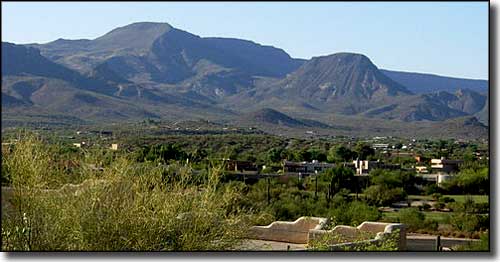
Cave Creek, Arizona

The view across Cave Creek
Once upon a time, the Cave Creek area was Hohokam Indian country. Then the Hohokam mysteriously disappeared around 1450 CE. They left artifacts, irrigation systems and petroglyphs behind but that's all we really know about them having been here. Then the European invaders arrived in 1870. They first came as soldiers intent on controlling the Tonto Apaches. After the military came the prospectors, and it seems some small amount of gold was found. Problem there, though, was more money was probably made by manipulating gold shares and fleecing the public than was made through the actual production of gold.
Cattle ranchers were the next wave of immigrants, and the Cave Creek area was good for them. By 1886 there were enough kids in the area to support a one-room schoolhouse (the norm in those days). But, of course, the folks thought more was better and when sheep ranchers arrived, the area got so over-grazed that the whole ranching business got really risky.
Then in the 1920's and 1930's came the tuberculosis sufferers in search of a cure. The hills around Cave Creek became dotted with rustic tuberculosis camps where the infected hoped sunshine and dry air would help. The 1930's also saw Cave Creek become a recreational and supply center for the men building Horseshoe and Bartlett Dams.
After the dam construction was complete, the town took on a slightly quieter air as high class dude ranches came into their own in the later 1940's and the 1950's. Many an East Coast greenhorn came to visit and got hooked on the Sonoran Desert lifestyle.
These days, the original dude ranch at Rancho Manana is a major resort complex with a championship golf course. And the former dude ranch at Spur Cross is now the 2,154-acre Spur Cross Ranch Conservation Area, owned and operated by Maricopa County Parks. But Cave Creek as a whole is still a relatively quiet community on the far north side of the Phoenix Metroplex.
Latitude: 33.8286°N
Longitude: 111.9548°W
Incorporated: 1986
Elevation: 2,126'
Education:
High School or Higher: 93.8%
Bachelor's Degree or Higher: 40.9%
Graduate or Professional Degree: 16.7%
2011 Cost of Living Index for Cave Creek: 91.2
Estimated Median Household Income: $83,000
Estimated Median Home Value: $525,200
Median Resident Age: 44.7 Years
Major Industries:
Construction, Professional Services, Educational Services, Health Care, Finance & Insurance Services, Real Estate Services, Lodging & Food Services, Entertainment & Recreation, Waste Management Services
Unemployed (March 2011): 8.5%
2010 Population Demographics
| Total Population | 5,015 |
| Males | 2,474 |
| Females | 2,541 |
| Population by Age | |
| Under 18 | 820 |
| 18 & over | 4,195 |
| 20-24 | 164 |
| 25-34 | 270 |
| 35-49 | 1,036 |
| 50-64 | 1,706 |
| 65 & over | 921 |
| Population by Ethnicity | |
| Hispanic or Latino | 408 |
| Non Hispanic or Latino | 4,607 |
| Population by Race | |
| White | 4,698 |
| African-American | 36 |
| Asian | 41 |
| Native American | 25 |
| Hawaiian or Pacific Islander | 4 |
| Other | 155 |
| Two or more | 56 |
